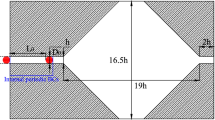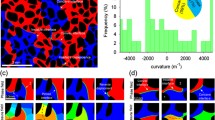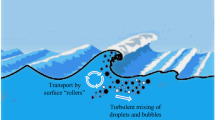Abstract
Wettability alternation phenomena is considered one of the most important enhanced oil recovery (EOR) mechanisms in the chemical flooding process and induced by the adsorption of surfactant on the rock surface. These phenomena are studied by a mesoscopic method named as dissipative particle dynamics (DPD). Both the alteration phenomena of water-wet to oil-wet and that of oil-wet to water-wet are simulated based on reasonable definition of interaction parameters between beads. The wetting hysteresis phenomenon and the process of oil-drops detachment from rock surfaces with different wettability are simulated by adding long-range external forces on the fluid particles. The simulation results show that, the oil drop is liable to spread on the oil-wetting surface and move in the form of liquid film flow, whereas it is likely to move as a whole on the water-wetting surface. There are the same phenomena occuring in wettability-alternated cases. The results also show that DPD method provides a feasible approach to the problems of seepage flow with physicochemical phenomena and can be used to study the mechanism of EOR of chemical flooding.
Similar content being viewed by others
References
Maitland G.C.: Oil and gas production. Curr. Opin. Colloid Interface Sci. 5, 301–311 (2000)
Buckley, J.S., Liu, Y., Monsterleet, S.: Mechanism of wetting alteration by crude oils. SPE 37230 (1997)
Shen P.P., Yu J.Y.: Fundamental Study on Extensively Enhanced Petroleum Recovery. Petroleum Industry Press, Beijing (2001) (in Chinese)
Zhao F.L.: EOR Principle. University of Petroleum Press, Dongying (2000) (in Chinese)
Guo S.P., Huang Y.Z., Zhou J. et al.: Porous Flow with Physicochemical Process (Microscopic Mechanism). Science Press, Beijing (1990)
Basu, S., Sharma, M.M.: Investigating the role of crude-oil components on wettability alteration using atomic force microscopy. SPE 37213 (1997)
Robin, M., Combes, R.: Wettability of porous media from environmental SEM: from model to reservoir rocks. SPE 37235 (1997)
Hoogerbrugge P.J., Koelman J.M.V.A.: Simulating microscopic hydrodynamic phenomena with mesoscopic simulation. Europhys. Lett. 19, 155 (1992)
Groot R., Warren P.: Dissipative particle dynamics: bridging the gap between atomistic and mesoscopic simulation. J. Chem. Phys. 107, 4423–4435 (1997)
Español P.: Dissipative particle dynamics with energy conservation. Europhys. Lett. 30, 191 (1995)
Español P., Koelman J.M.V.A.: Statistical mechanics of dissipative particle dynamics. Europhys. Lett. 40, 141 (1997)
van Vliet R.E., Hoefsloot H.C., Iedema P.D.: Mesoscopic simulation of polymer-solvent phase separation: Linear chain behavior and branching effects. Polymer 44, 1757–1763 (2003)
Fan X.J., Nhan P.T., Chen S. et al.: Simulating flow of DNA suspension using dissipative particle dynamics. Phys. Fluids 18, 063102 (2006)
Tiwari A., Abraham J.: Dissipative particle dynamics model for two-phase flows. Phys. Rev. E 74, 056701 (2006)
Vasileios S., Karniadakis G.E.: A family of time-staggered schemes for integrating hybrid DPD models for polymers: Algorithms and applications. J. Comput. Phys. 218, 82–101 (2006)
Somfai E., Morozov A.N., van Saarloos W.: Modeling viscoelastic flow with discrete methods. Physica A 362, 93–97 (2006)
Revenga M., Zuniga I., Español P.: Boundary model in DPD. Int. J. Mod. Phys. 9, 1319 (1998)
Willensen S.M., Hoefsloot H.C., Iedema P.D.: No-slip boundary condition in dissipative particle. Int. J. Mod. Phys. 11, 881–890 (2000)
Fan X.J., Phan-Thien N., Yong N.T. et al.: Microchannel flow of a macromolecular suspension. Phys. Fluids 15, 11–12 (2003)
Pivkin I.V., Karniadakis G.E.: Controlling density fluctuations in wall-bounded dissipative particle dynamics systems. Phys. Rev. Lett. 96, 206001 (2006)
Nikunen P., Karttunen M., Vattulainen I.: How would you integrate the equations of motion in dissipative particle dynamics simulations. Comput. Phys. Commun. 153, 407–423 (2003)
Fan C., Olafson B., Blanco M. et al.: Application of molecular simulation to derive phase diagrams of binary mixtures. Macromolecules 25, 3667 (1992)
Author information
Authors and Affiliations
Corresponding author
Additional information
The project was supported by the National Basic Research Program of China (973 Program) (2005CB221304).
Rights and permissions
About this article
Cite this article
Li, X., Liu, Y., Tang, J. et al. Dissipative particle dynamics simulation of wettability alternation phenomena in the chemical flooding process. Acta Mech Sin 25, 583–587 (2009). https://doi.org/10.1007/s10409-009-0247-5
Received:
Revised:
Accepted:
Published:
Issue Date:
DOI: https://doi.org/10.1007/s10409-009-0247-5




